Morella cordifolia
Morella cordifolia (L.) Killick (= Myrica cordifolia )
Family: Myricaceae
Common names: wax berry, candle berry (Eng.); wasbessie, wasbessiebos, wasbossie, glashout (Afr.); ilethi (Zulu)
Introduction
The wax berry is an interesting addition to the garden, ideal for coastal and/or sandy gardens, and if you like plants with a long history of use to mankind then this is a plant for you.
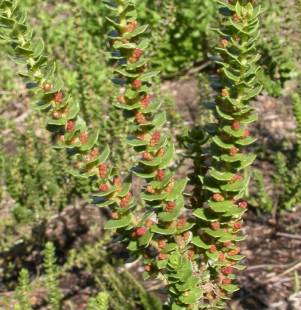
Description
Description
A low-growing, evergreen, spreading shrub. It sends out slender branches horizontally that lie along the ground, with upright-growing shoots that can reach up to 2 or 3 m in height. When seen growing in loose sand, these horizontal branches are usually covered by the shifting sands and all that we see are the upright shoots sticking out above the sand. It is not an aggressive rooter, although roots are occasionally formed where the horizontal branches touch the ground.
A single plant can cover an area of 7 m2. The leaves are small, shiny, heart-shaped, toothed and gland-dotted. They have no stalk and are arranged densely and neatly along the branches-like overlapping roof tiles. Crushed leaves have a faint, sweet scent.
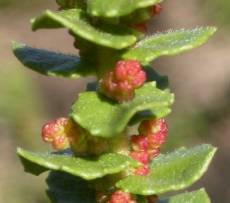
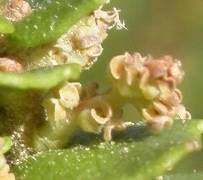
The sexes are separate. Male plants produce many solitary catkin-like flowers in the axils of the leaves. Red-tinged buds open and elongate to yellow-brown spikes, 2-5 mm long, and if you tap a branch a cloud of pollen is released. The female flowers are densely clustered around the stem, usually quite low down on the plant, and develop into 5-8 mm diameter, purple-blue, round berries covered with a warty layer of wax that gives them a silvery sheen.
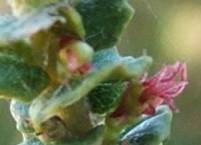
Each berry consists of a single hard seed surrounded by a fruit coat which is surrounded by a thick waxy layer. Flowers appear in autumn-winter (April-June); the fruits appear a few months later and remain on the bush throughout the summer. At Kirstenbosch, at present, there are no female plants in the Garden.
Distribution and habitat
Distribution description
Coastal sands and dunes, and sandy flats of the Western and Eastern Cape, from Langebaan to the Cape Peninsula to near the Kei River mouth.
Derivation of name and historical aspects
History
I cannot verify the derivation of the genus name Morella: it is most likely named for its fruits, from morus the Latin name for the mulberry tree and ell being diminutive. According to my Mother's old list of names which has long since lost its cover, the girl's name Mora/Morella/Morina, is from a Spanish root and means blueberry. There is also a cherry called the Morella or Morello cherry. It could also be named after Morella, the picturesque town with a fort in eastern Spain.
The derivation of Myrica is also not entirely clear, it could be from the Greek myrike, which means shrub by the riverside (probably originally the Tamarisk), or it could be from muron meaning a scent or myrio to flow. It was also a name for Venus. The Latin species name cordifolium means with heart-shaped leaves.
This species has attracted more than one common name. They mostly refer to its fruits that are covered with a waxy coating or to what the wax is used for. The name glashout (glass wood) refers to its brittle stems and branches.
Myricaceae is classified in the Hamamelidae and is made up of four genera: Morella, Myrica, Comptonia and Canacomyrica, which are widely distributed but occur mostly in temperate to subtropical regions and tropical highlands. Over 300 fossil species have also been described, mostly from the Tertiary (65 to 1.8 mya) of North America and Europe.
Canacomyrica is endemic to New Caledonia but fossils of it are recorded from the Eocene (54 to 37 mya) and Miocene (23 to 5 mya) of New Zealand. Comptonia is endemic to eastern North America. Only Morella is represented in southern Africa.
This family has recently been revised and many species previously in the genus Myrica have been renamed in the genus Morella. Morella is the largest genus, with about 53 described species that occur in North America, Europe, Africa and Asia.
There are 10 species of Morella in southern Africa, they occur mainly in the Western and Eastern Cape but also in Namibia, Botswana, North-West, Northern Cape, Free State, Limpopo, Gauteng, Mpumalanga, Swaziland, KwaZulu-Natal and Lesotho. They are: Morella brevifolia, M. diversifolia, M. humilis, M. integra, M. kraussiana, M. microbracteata, M. pilulifera, M. quercifolia, M. serrata and M. cordifolia.
It is a problematic genus in that the species are variable yet have a very similar floral structure; the differences between the species are based almost entirely on vegetative characters.
Ecology
Ecology
Morella cordifolia is wind-pollinated, the male plants produce quite a lot of pollen, which is very popular with the bees. The fruits on the female plants remain on the plant for months forming an aerial seed bank. Birds eat the berries and thus also disperse the seeds. The possibility that the seeds may also be dispersed by the sea was disproved: although most of the seeds survived being immersed in salt water for three months (possibly protected by the waxy layer) the fruits are not buoyant and sink after a few days.
The roots of Morella cordifolia are associated with arbuscular mycorrhizal fungi that grow in and around the roots but are beneficial to the plant because, although they take carbohydrate from the plant, they assist the plant by absorbing nutrients, particularly phosphorous, from the soil. The roots also possess root nodules that contain nitrogen-fixing bacteria that convert nitrogen in the soil to ammonia, and transfer the ammonia to the plant which the plant uses to make proteins, enzymes and chlorophyll.
Uses
Use
Morella cordifolia was a valuable plant in the domestic life of the early colonists who obtained a fine wax from the layer of wax that covers the fruits. The process of obtaining wax was first noted by Thunberg in 1772; the berries are thrown into boiling water and the molten wax which floats is skimmed off and strained through muslin or other cloth into cold water. The solidified wax is pressed into cakes, then remelted and cast into moulds and then bleached in the sun.
The wax makes an excellent polish (some consider it superior to beeswax), it was used as an ointment for dressing wounds, to make candles and to make soap.
The berry wax has also been eaten as a food since early times, in particular by the Khoi. The wax is in fact not wax, but a true fat. The fruit coat yields 20% of a fat consisting of the glycerides of stearic, palmitic and myristic acids, lauric acid and unsaturated fatty acids. The kernel yields 1.85% oil, which is pale yellow-green in colour and rich in free fatty acids, mainly unsaturated, and palmitic and myristic acids. Only 9% of the total acid content is saturated.
Unfortunately, the colour and its high content of free fatty acids and unsaponifiable material render it unsuitable for industrial exploitation. [If a fatty substance is heat-treated with an alkaline solution, like caustic soda, soap is formed (saponification). After this treatment the material that can be extracted with a suitable solvent is called unsaponifiable matter. Unsaponifiable fats contain a number of compounds such as sterols, hydrocarbons, pigments, fatty acids and vitamins. Certain problem compounds are contained in the hydrocarbon portion.]
The bark of the roots and stems was used for tanning skins. The bark from stems and rhizomes was used medicinally as an astringent. The flower is said to yield a volatile oil.
This plant is also an effective sand binder on coastal sand dunes and was so used by the Dept. of Forestry in the early 1900s before alien species were used instead. Lately, the threat to indigenous vegetation caused by these aliens has prompted a search for suitable indigenous species, so once again, Morella cordifolia is being used for dune stabilization.
Morella cordifolia was an important source of income in former times. In 1778 and again in 1846 the government of the day declared it a protected species; nevertheless, Dr Pappe noted in 1862 that the plants on the Cape Flats were still being destroyed.
In 1886 at the 'Colonial and Indian Exhibition' in London, samples of bessiewas (berry wax) were on display. In those days the wax cost 2-3¼ pence per pound in Cape Town, and 1 shilling per pound in Europe, later on it fetched £30-40 per pound in London.
In 1907 the seed was being harvested and sown to stabilize sand dunes, particularly on the Cape Flats. Today on the Cape Flats, the wax berry and other indigenous dune plants are smothered under alien invaders such as the rooikrans (Acacia cyclops) and the Port Jackson willow (Acacia saligna) or have been displaced by the ever-growing housing settlements and industrial developments.
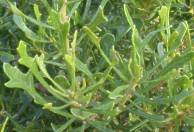
Many of the other species of Morella and Myrica are used medicinally or for their wax. The leaves of Morella quercifolia, which can also be seen at Kirstenbosch, are used in an old Cape remedy for the relief of stomachache.
Growing Morella cordifolia
Grow
Morella cordifolia is not difficult to grow and is ideally suited to sandy and/or coastal gardens as it tolerates salty spray. It does well in sun or semi-shade, in well-drained soil and will tolerate poor soils but will perform better if generously mulched with compost at least once or twice a year. This shrub has a tendency to spread and sends out sideways-growing shoots in odd directions. Prune to keep low or tidy.
Seed germinates readily, and the waxy layer does not appear to inhibit germination in any way although it is recommended that the fruit and wax layers be removed before sowing. Sow in autumn or spring. Seed germinates in 3 to 4 weeks.
This plant is easily propagated by cuttings taken in spring-use semi-hardwood and a rooting hormone and place under mist until rooted. It should also be easy to root by layering.
References
- Germishuizen, G. & Meyer, N.L. (eds). 2003. Plants of southern Africa : an annotated checklist. Strelitzia 14. National Botanical Institute, Pretoria.
- Jackson, W.P.U. 1990. Origins and meanings of names of South African plant genera. U.C.T. Printing Dept., Cape Town.
- Killick, D.J.B. 1969. The South African species of Myrica. Bothalia 10: 5-17.
- Knevel, I.C. 2001. The life history of selected coastal foredune species of South Africa. Ph.D., Rhodes University, Grahamstown.
- Leistner, O.A. (ed.). 2000. Seed plants of southern Africa : families and genera. Strelitzia 10. National Botanical Institute, Pretoria.
- Malan, C. 1982. Myrica cordifolia- die wasbessie. Veld & Flora 68: 122.
- Manning, J. & Goldblatt, P. 1996. West Coast. South African Wild Flower Guide 7. Botanical Society of South Africa, Cape Town.
- Polhill, R.M. & Verdcourt, B. 2000. Myricaceae. Flora of tropical East Africa. Balkema, Rotterdam.
- Smith, C.A. 1966. Common names of South African plants. Memoirs of the Botanical Survey of South Africa No. 35.
- Watt, J.M. & Breyer-Brandwyk, M.G. 1962. The medicinal and poisonous plants of southern and eastern Africa, edn 2. Livingstone, Edinburgh & London.
Credits
Alice Notten
Kirstenbosch National Botanical Garden
May 2005
Plant Attributes:
Plant Type: Shrub
SA Distribution: Eastern Cape, Western Cape
Soil type: Sandy
Flowering season: Autumn, Winter
PH: Acid, Neutral
Flower colour: Brown, Red, Yellow
Aspect: Full Sun
Gardening skill: Easy
Special Features:
Horticultural zones











Rate this article
Article well written and informative
Rate this plant
Is this an interesting plant?
Login to add your Comment
Back to topNot registered yet? Click here to register.